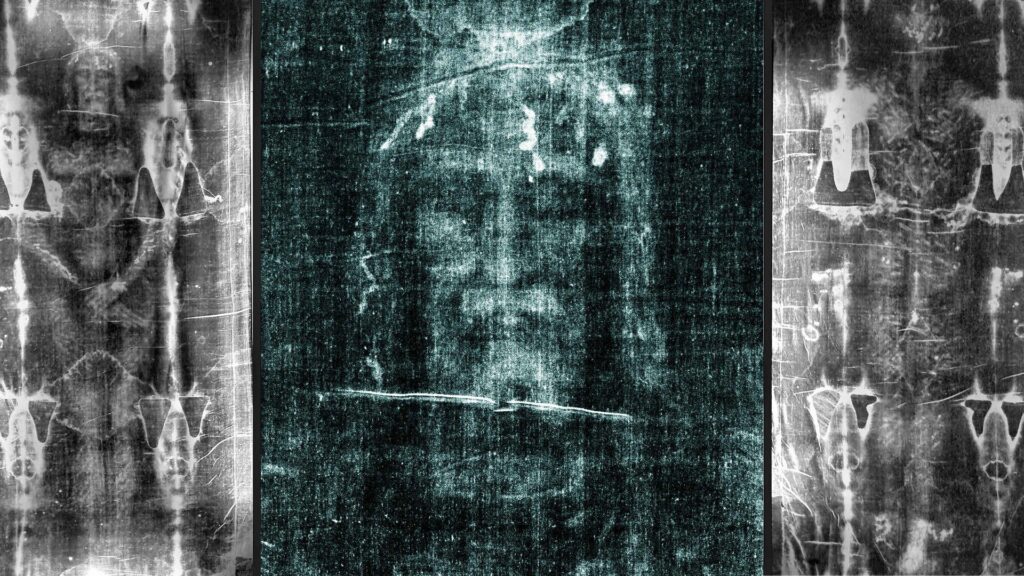Historical Background
The Shroud of Turin first appeared in historical records in the 14th century. Its earliest documented appearance was in 1353 in the small town of Lirey, France. It was displayed by a French knight, Geoffroi de Charny, in a church built for the purpose. How the shroud came into his possession remains unclear, leading to speculation about its origins.
The Shroud eventually made its way to Turin, Italy, in 1578, where it has been housed in the Cathedral of Saint John the Baptist ever since. While many believe the Shroud to be the burial cloth of Jesus Christ, used to wrap His body after His crucifixion, no conclusive evidence links it to Christ’s burial.

The Image on the Shroud
One of the most intriguing aspects of the Shroud of Turin is the faint, ghostly image of a man on the cloth. The image is often interpreted as the front and back of a crucified man, showing wounds consistent with crucifixion, such as nail marks on the wrists and feet, and a wound on the side.
The man in the image also appears to have suffered from a crown of thorns, matching the description of Jesus’ Passion in the New Testament.
However, the method by which the image was created remains a mystery. The image is not painted, nor is it a photographic negative. Instead, it seems to be a scorch-like imprint on the linen fibers. This has led to numerous theories, ranging from naturalistic explanations to supernatural ones.
Scientific Investigations
The Shroud of Turin has been the subject of extensive scientific investigation, with varying results. In 1978, a team of scientists from the Shroud of Turin Research Project (STURP) conducted a detailed examination of the cloth. They concluded that the image was not the result of pigment, dye, or any known artistic technique, but the exact mechanism of image formation remained unknown.
In 1988, the Shroud underwent radiocarbon dating by three separate laboratories, which suggested that the cloth dated to the Middle Ages, between 1260 and 1390, thus seemingly disproving its authenticity as Jesus’ burial shroud.
However, this conclusion has been challenged by some researchers who argue that the samples used for the dating were taken from a repaired section of the cloth and may not reflect the age of the entire Shroud.
More recent studies have focused on the presence of pollen grains, bloodstains, and other materials on the Shroud. Some pollen samples match species found in the region around Jerusalem, leading some to argue for a Middle Eastern origin of the cloth. Additionally, forensic analysis of the bloodstains suggests that they are consistent with human blood.
Religious Significance
For many Christians, particularly within the Catholic Church, the Shroud of Turin holds deep spiritual significance. Pope John Paul II referred to it as a “mirror of the Gospel,” and millions of pilgrims have traveled to Turin to view the Shroud during its rare public displays.
Even for those who do not believe in its authenticity as the burial cloth of Jesus, the Shroud serves as a powerful symbol of Christ’s suffering and sacrifice.
The Vatican has not officially declared the Shroud to be authentic, but it allows and even encourages veneration of the relic. Popes have expressed reverence for the Shroud, considering it an object of faith and devotion, regardless of its historical origins.
Controversies and Theories
The Shroud of Turin continues to be a source of controversy and debate. Skeptics argue that it is a clever medieval forgery, created to attract pilgrims and generate revenue for the church. Some have suggested that the image could have been created using early photographic techniques or artistic methods involving chemicals and heat.
On the other hand, proponents of the Shroud’s authenticity point to the anatomical accuracy of the image, the presence of specific blood types, and the historical connection to the Middle East as evidence that it could indeed be the burial cloth of Jesus Christ.
The Shroud has also inspired numerous theories ranging from the plausible to the fantastical. Some suggest that the image was created by a burst of radiation during Jesus’ resurrection, while others propose more mundane explanations involving natural processes or medieval artistry.
Conclusion
The Shroud of Turin remains one of the most enigmatic and controversial religious relics in history. Despite extensive scientific examination, the mystery of how the image was formed and whether it is truly the burial cloth of Jesus Christ endures. For believers, it remains a powerful symbol of faith, while for skeptics, it represents a fascinating puzzle of medieval history.
Regardless of one’s stance, the Shroud continues to captivate the imagination and inspire debate among scholars, scientists, and the faithful alike.
